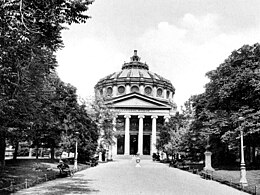| Romanian Rhapsodies | |
|---|---|
| Orchestral music by George Enescu | |
 Romanian Athenaeum, at about the time of the premiere there | |
| Key | |
| Opus | 11 |
| Composed | 1901 |
| Dedication | Bernard Crocé-Spinelli (No. 1) |
| Performed | 23 February 1903 Romanian Athenaeum, Bucharest |
| Movements | 2 |
| Scoring | orchestra |
The two Romanian Rhapsodies, Op. 11, for orchestra, are George Enescu's best-known compositions. They were written in 1901, and first performed together in 1903. The two rhapsodies, and particularly the first, have long held a permanent place in the repertory of every major orchestra. They employ elements of lăutărească music, vivid Romanian rhythms, and an air of spontaneity. They exhibit exotic modal coloring, with some scales having 'mobile' thirds, sixths or sevenths, creating a shifting major/minor atmosphere, one of the characteristics of Romanian music.[1] They also incorporate some material found in the later drafts of Enescu's Poème roumaine, Op. 1.[2]
- ^ Maria Zlateva Zlateva, "Romanian Folkloric Influences on George Enescu's Artistic and Musical Development as Exemplified by His Third Violin Sonata", DMA thesis (Austin: The University of Texas at Austin, 2003), 18.
- ^ Maria Zlateva Zlateva, "Romanian Folkloric Influences on George Enescu's Artistic and Musical Development as Exemplified by His Third Violin Sonata", DMA thesis (Austin: The University of Texas at Austin, 2003), 16